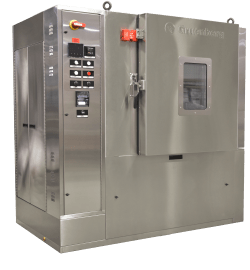What is Dry Heat Sterilization? A Guide To The Dry Heat Sterilization Process
Dry heat sterilization uses hot air to raise the temperature of an item to above a validated temperature which eliminates, removes, kills or deactivates biological contaminants and other biological agents on the object. These biological contaminants may include fungi, bacteria, viruses, spore forms and prions. The dry heat sterilization cycle is dependent on time and temperature, meaning as the temperature is increased the amount of time to achieve sterilization is decreased.
The Dry Heat Sterilization Process
Dry heat sterilization relies on heat conduction and heat convection. During the process, hot air sterilizers are used to heat up objects for decontamination. The objects within the sterilizer absorb the heat which eliminates any pathogens on the items. The process uses specific time and temperature calculations to eliminate pathogens. If the time-temperature relationship is broken or incorrect, it may leave the items unsterile.
The most efficient hot air sterilizers use mechanical convection technology with forced air. In these units a motor-driven blower moves the hot air rapidly from one object to another at a high velocity. With a more rapid heat-up, the time needed to complete a sterilization cycle is shorter.
To begin the process of dry heat sterilization, place the objects you are treating in the sterilizer chamber. Once the object is in place, close the door and keep it secure for the established timeframe needed to complete the cycle. Do not open the sterilizer at any point during the cycle. Opening the door will interrupt the sterilization process and ruin the progress of the cycle.
What is Dry Heat Sterilization Used For?
Dry heat sterilization is used for range of decontamination processes. In addition to using this method for materials that are impenetrable by steam it is used for materials that may degrade if exposed to moisture. A few examples of dry heat sterilization uses:
- Aseptic processing of pharmaceuticals because it preserves moisture-sensitive items. These include glass, non-aqueous materials, silicone prostheses, and electronics.
- Depyrogenation or to inactivate stubborn microbes in the pharmaceutical industry
- To prevent contamination in regenerative medicine in cancer research laboratories and to eliminate contaminants during diagnostic analyses.
- It is beneficial for cell cultivation in CO2 incubators.
- Decontamination of cages in the lab animal science industry
- Sterilizing spacecraft equipment.
- Silicone implants that are impermeable to steam.
Advantages of Dry Heat Sterilization
There are several advantages of dry heat sterilization that range from simplicity to cost-effectiveness. These include:
- Ease of installation – modular units are available and no water connection required.
- Ease of maintenance – minimal maintenance items on units and less component deterioration because no exposure to moisture.
- Lower operational costs than steam sterilizers – the only utility required is electricity.
- Mechanical convection technology provides a rapid heat-up rate and shorter cycle times.
- Can be used in circumstances where materials may be damaged by steam or are difficult to sterilize with steam.
- Can be used for products that would be inactivated by steam and electronics prone to irradiation
Dry Heat Sterilizer Solutions from Gruenberg
Whether you need to decontaminate laboratory equipment, pharmaceutical products, or animal habitats, dry heat sterilizers are a top choice. Dry heat sterilizers provide a number of advantages over other methods, including accuracy, ease of use, and cost effectiveness. Gruenberg offers a variety of dry heat sterilizers to meet your needs. The experienced team at Gruenberg is available to answer questions on specific processes and equipment requirements. If you’re unsure about what dry heat sterilization is right for you contact us.




